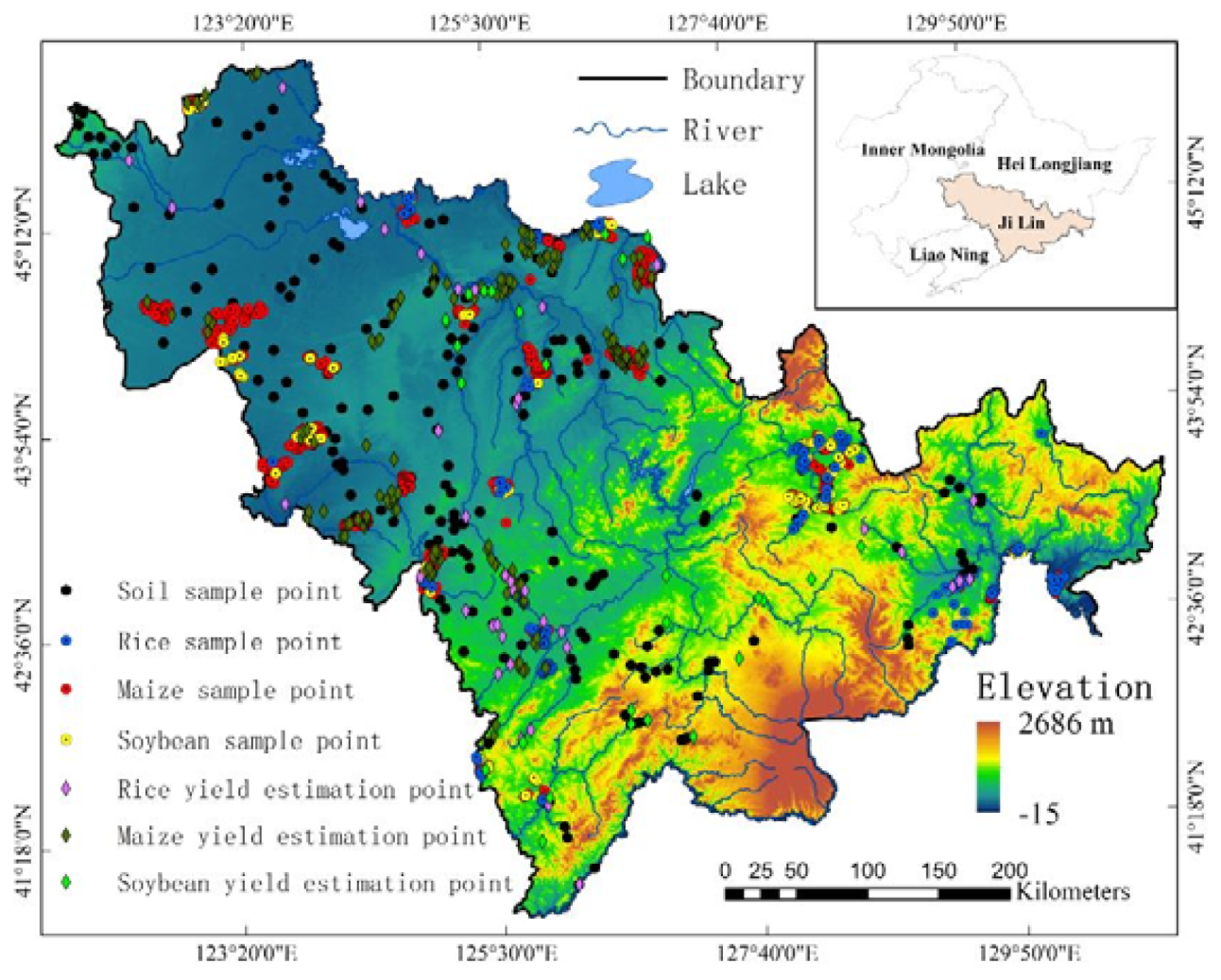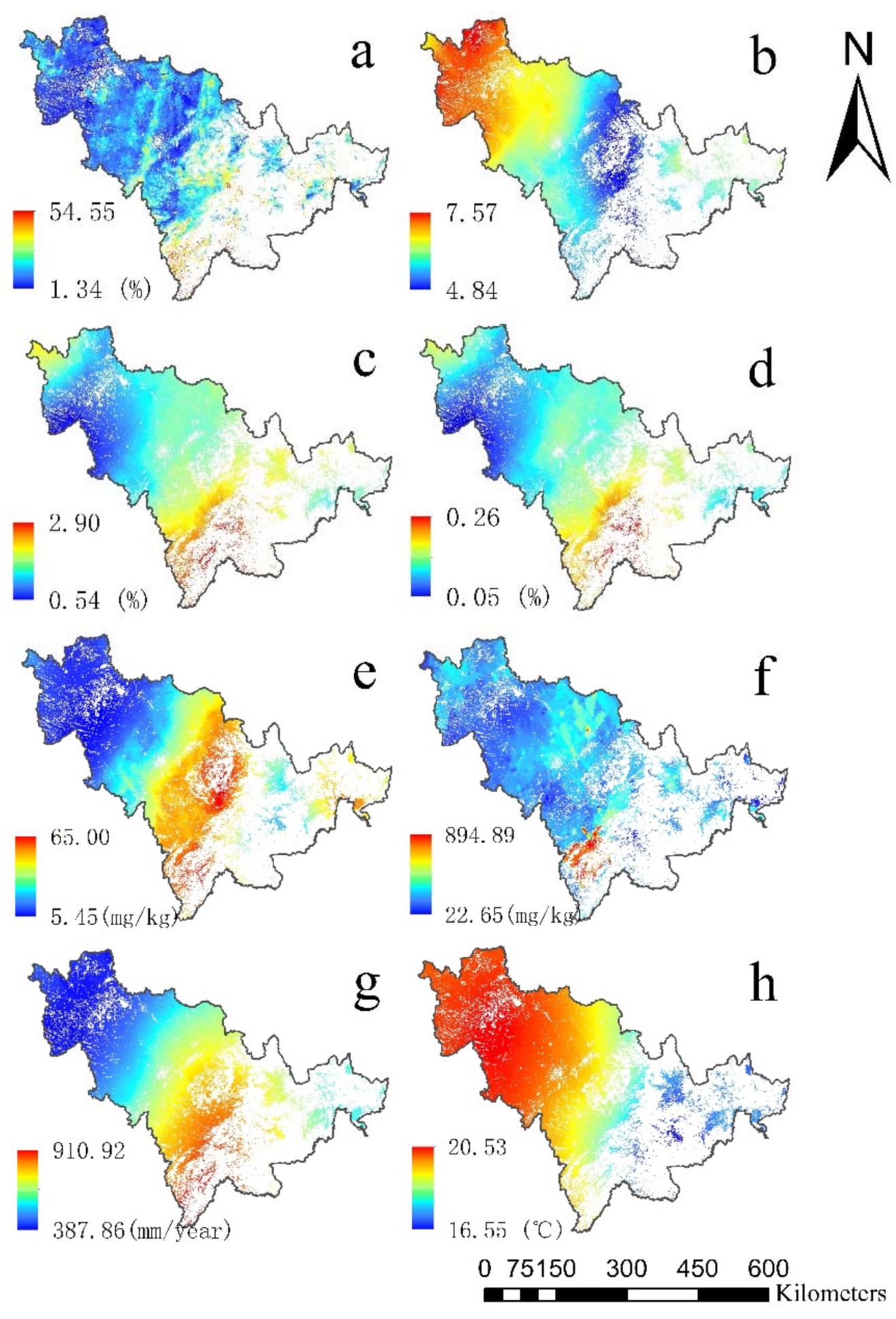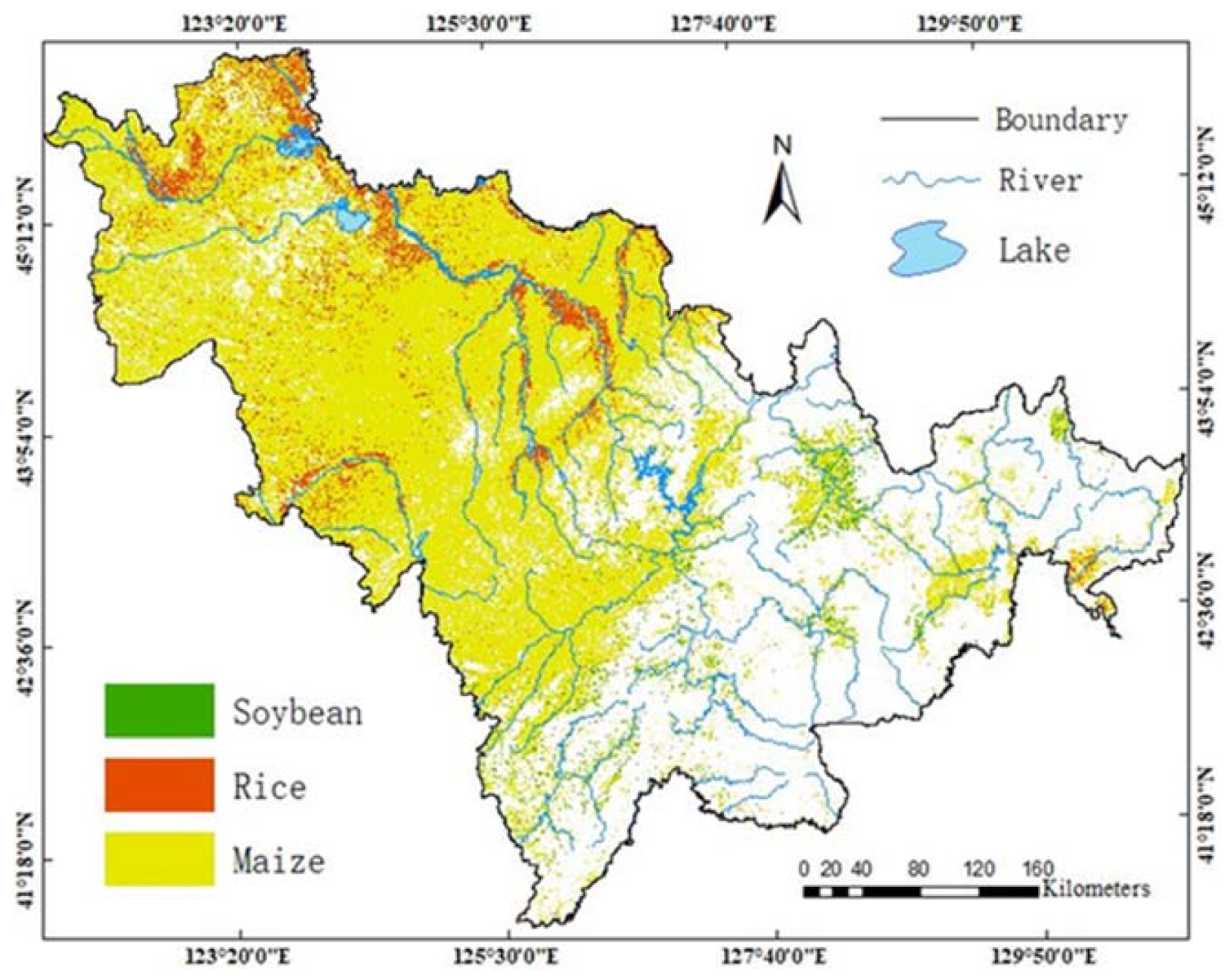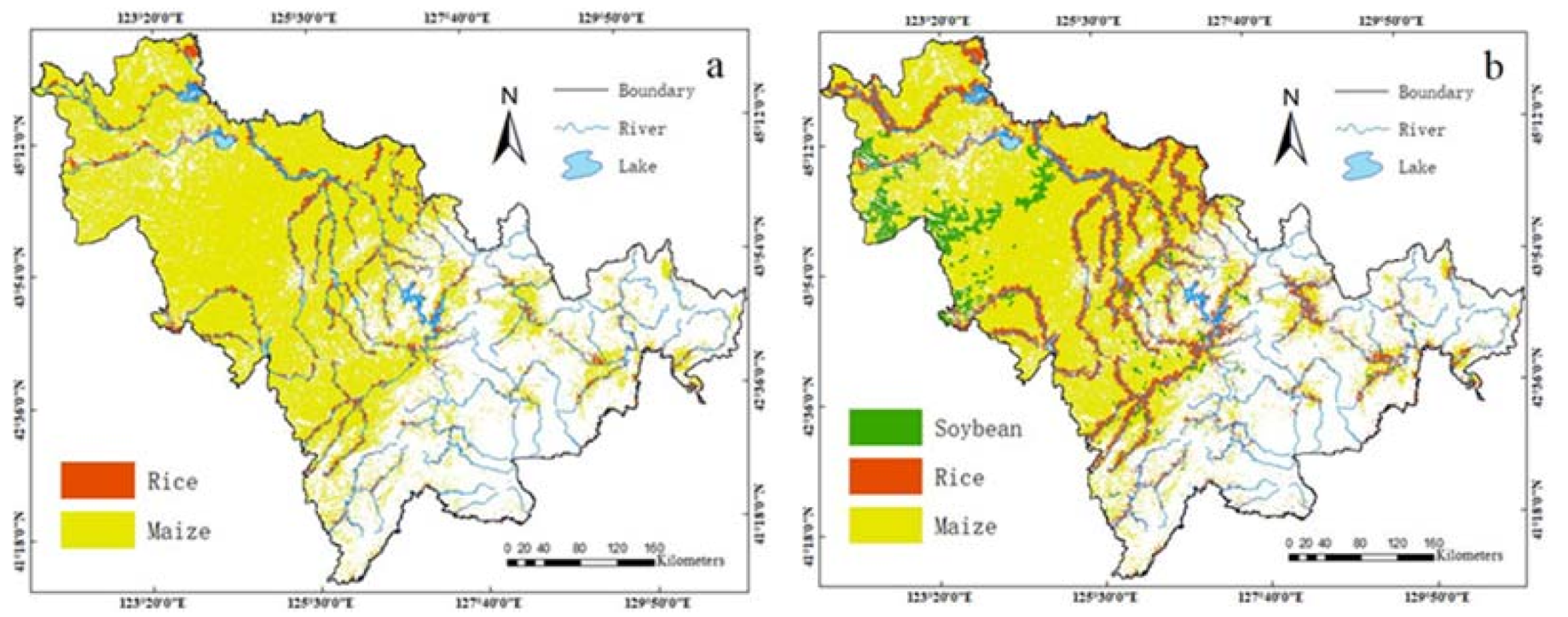Evaluation of Agricultural Land Suitability Based on RS, AHP, and MEA: A Case Study in Jilin Province, China
Abstract
1. Introduction
2. Materials and Methods
2.1. Identification of Evaluation Factors
2.1.1. Topography
2.1.2. Physical Soil Characteristics
2.1.3. Soil Fertility Characteristics
2.1.4. Climate Characteristics
2.1.5. Location Condition
2.2. Samples and Preparation of Data
2.3. Methods
2.3.1. Matter Element Analysis (MEA)
2.3.2. Analytical Hierarchy Process (AHP)
2.3.3. Classification Method of the Remote Sensing Data
2.3.4. Method of Planting Structure Optimization
3. Results
3.1. The Mapping of Different Crops
3.2. Implementation of Land Suitability Assessment
3.3. Suitability Analysis Results
3.3.1. Climatic Suitability
3.3.2. Topographic Suitability
3.3.3. Soil Nutrient Suitability
3.3.4. Soil Type Suitability
4. Discussion
4.1. Comparison and Discussion on Land Suitability Evaluation Methods
4.2. Analysis of Spatial Planting Structure
4.2.1. Discussion of Different Planting Structures
4.2.2. Adjustment of the Existing Planting Structure
5. Conclusions
Author Contributions
Funding
Institutional Review Board Statement
Informed Consent Statement
Data Availability Statement
Conflicts of Interest
References
- Food and Agriculture Organization (FAO). A Framework for Land Evaluation; FAO Soils Bulletin, 32; Food and Agriculture Organization: Rome, Italy; International Institute for Land Reclamation and Improvement: Wangeningen, The Netherlands, 1976. [Google Scholar]
- Collins, M.G.; Rushman, F.R.S.J. Land-use suitability analysis in the United States: Historical development and promising technological achievements. Environ. Manag. 2001, 28, 611–621. [Google Scholar] [CrossRef] [PubMed]
- Mendas, A.; Delali, A. Integration of multi-criteria decision analysis in GIS to develop land suitability for agriculture: Application to durum wheat cultivation in the region of Mleta in Algeria. Comput. Electron. Agric. 2012, 83, 117–126. [Google Scholar] [CrossRef]
- Fontes, M.P.F.; Fontes, R.M.O.; Carneiro, P.; Cio, A.S. Land suitability, water balance and agricultural technology as a Geographic-Technological Index to support regional planning and economic studies. Land Use Policy 2009, 26, 589–598. [Google Scholar] [CrossRef]
- Kazemi, H.; Sadeghi, S.; Akinci, H. Developing a land evaluation model for faba bean cultivation using geographic information system and multi-criteria analysis (A case study: Gonbad-Kavous region, Iran). Ecol. Indic. 2016, 63, 37–47. [Google Scholar] [CrossRef]
- Falasca, S.L.; Ulberich, A.C.; Ulberich, E. Developing an agro-climatic zoning model to determine potential production areas for castor bean (Ricinus communis L.). Ind. Crops Prod. 2012, 40, 185–191. [Google Scholar] [CrossRef]
- Baroudy, A.A.E. Mapping and evaluating land suitability using a GIS-based model. Catena 2016, 140, 96–104. [Google Scholar] [CrossRef]
- Gowda, J.V.; Anilkumar, S.N.; Sathish, A.; Parama, V.R.R. Soil fertility mapping, land suitability assessment for suggesting maize and pomegranate crops in Hosakere micro-watershed of Davanagere district, Karnataka. J. Soil Water Conserv. 2018, 17, 75–82. [Google Scholar] [CrossRef]
- Hoseini, Y.; Kamrani, M. Using a fuzzy logic decision system to optimize the land suitability evaluation for a sprinkler irrigation method. Outlook Agric. 2018, 47, 298–307. [Google Scholar] [CrossRef]
- Abd-Elmabod, S.K.; Muoz-Rojas, M.; Jordán, A.; Anaya-Romero, M.; Phillips, J.D.; Jonesh, L.; Zhang, Z.; Pereira, P.; Fleskens, L.; van der Ploeg, M.; et al. Climate change impacts on agricultural suitability and yield reduction in a Mediterranean region. Geoderma 2020, 374, 114453. [Google Scholar] [CrossRef]
- Dong, Z.; Pan, Z.; Wang, S.; An, P.; Zhang, J.; Zhang, J.; Pan, Y.; Huang, L.; Zhao, H.; Han, G.; et al. Effective crop structure adjustment under climate change. Ecol. Indic. 2016, 69, 571–577. [Google Scholar] [CrossRef]
- Zhang, J.Q.; Su, Y.R.; Wu, J.S.; Liang, H.B. GIS based land suitability assessment for tobacco production using AHP and fuzzy set in Shandong province of China. Comput. Electron. Agric. 2015, 114, 202–211. [Google Scholar] [CrossRef]
- Wanyama, D.; Mighty, M.; Sim, S.; Koti, F. A Spatial Assessment of Land Suitability for Maize Farming in Kenya. Geocarto Int. 2019, 11, 1–18. [Google Scholar] [CrossRef]
- Jahanshiri, E.; Nizar, N.M.M.; Suhairi, T.A.S.T.M.; Gregory, P.J.; Mohamed, A.S.; Wimalasiri, E.M.; Azam-Ali, S.N. A Land Evaluation Framework for Agricultural Diversification. Sustainability 2020, 12, 3110. [Google Scholar] [CrossRef]
- Najafabadi, M.M.; Ziaee, S.; Nikouei, A.; Borazjani, M.A. Mathematical programming model (MMP) for optimization of regional cropping patterns decisions: A case study. Agric. Syst. 2019, 173, 218–232. [Google Scholar] [CrossRef]
- Zolekar, R.B.; Bhagat, V.S. Multi-criteria land suitability analysis for agriculture in hilly zone: Remote sensing and GIS approach. Comput. Electron. Agric. 2015, 118, 300–321. [Google Scholar] [CrossRef]
- Bennett, R.; Oosterom, P.; Lemmen, C.; Koeva, M. Remote Sensing for Land Administration. Remote. Sens. 2020, 12, 2497. [Google Scholar] [CrossRef]
- Ceballos-Silva, A.; Lopez-Blanco, J. Delineation of suitable areas for crops using a Multi-Criteria Evaluation approach and land use/cover mapping: A case study in Central Mexico. Agric. Syst. 2003, 77, 117–136. [Google Scholar] [CrossRef]
- Pilevar, A.R.; Matinfar, H.R.; Sohrabi, A.; Sarmadian, F. Integrated fuzzy, AHP and GIS techniques for land suitability assessment in semi-arid regions for wheat and maize farming. Ecol. Indic. 2020, 110, 105887. [Google Scholar] [CrossRef]
- Said, N.; Henning, B.; Joachim, H. Digital Mapping of Soil Properties Using Multivariate Statistical Analysis and ASTER Data in an Arid Region. Remote. Sens. 2015, 7, 1181–1205. [Google Scholar]
- Vincent, D.R.; Deepa, N.; Elavarasan, D.; Srinivasan, K.; Chauhdary, S.H.; Iwendi, C. Sensors Driven AI-Based Agriculture Recommendation Model for Assessing Land Suitability. Sensors 2019, 19, 3667. [Google Scholar] [CrossRef]
- Ferguson, C.A.; Bowen, R.L. Statistical evaluation of an agricultural land suitability model. Environ. Manag. 1991, 15, 689–700. [Google Scholar] [CrossRef]
- Wang, F. The use of artificial neural networks in a geographical information system for agricultural land-suitability assessment. Environ. Plann. A 1994, 26, 265–284. [Google Scholar] [CrossRef]
- Dedeoglu, M.; Dengiz, O. Generating of land suitability index for wheat with hybrid system aproach using AHP and GIS. Comput. Electron. Agric. 2019, 167, 1–15. [Google Scholar] [CrossRef]
- Cheng, L.; Hu, Z.; Lou, S. Improved methods for fuzzy comprehensive evaluation of the reclamation suitability of abandoned mine lands. Int. J. Mining Reclam. Environ. 2017, 31, 212–229. [Google Scholar] [CrossRef]
- Pan, G.B.; Xu, Y.P.; Yu, Z.H.; Song, S.; Zhang, Y. Analysis of river health variation under the background of urbanization based on entropy weight and matter-element model: A case study in Huzhou City in the Yangtze River Delta, China. Environ. Res. 2015, 139, 31–35. [Google Scholar] [CrossRef]
- Feng, L.; Hong, W. Application of matter element analysis in weather forecasting. Meteorol. Appl. 2014, 21, 398–402. [Google Scholar] [CrossRef]
- Xiao, Q.; Wan, S.; Lu, F.; Li, S. Risk assessment for engagement in sharing economy of manufacturing enterprises: A matter–element extension based approach. Sustainability 2019, 11, 4774. [Google Scholar] [CrossRef]
- Cai, W. Extension theory and its application. Chin. Sci. Bull. 1999, 44, 1538–1548. [Google Scholar] [CrossRef]
- Xie, X.F.; Pu, L.J. Assessment of urban ecosystem health based on matter element analysis: A case study of 13 cities in Jiangsu Province, China. Int. J. Environ. Res. Public Health 2017, 14, 940. [Google Scholar] [CrossRef]
- Su, M.; Xie, H.; Yue, W.; Zhang, L.; Yang, Z.; Chen, S. Urban ecosystem health evaluation for typical Chinese cities along the Belt and Road. Ecol. Indic. 2019, 101, 572–582. [Google Scholar] [CrossRef]
- He, Y.-X.; Dai, A.-Y.; Zhu, J.; He, H.-Y.; Li, F. Risk assessment of urban network planning in china based on the matter-element model and extension analysis. Int. J. Electr. Power Energy Syst. 2011, 33, 775–782. [Google Scholar] [CrossRef]
- Wang, Q.; Li, S.; He, G.; Li, R.; Wang, X. Evaluating sustainability of Water-Energy-Food (WEF) Nexus using an improved matter-element extension model: A case study of China. J. Clean. Prod. 2018, 202, 1097–1106. [Google Scholar] [CrossRef]
- Halil, A.; Ayşe, Y.Ö.; Bülent, T. Agricultural land use suitability analysis using GIS and AHP technique. Comput. Electron. Agric. 2013, 97, 71–82. [Google Scholar]
- Yilmaz, F.C.; Zengin, M.; Cure, C.T. Determination of ecologically sensitive areas in Denizli province using geographic information systems (GIS) and analytical hierarchy process (AHP). Environ. Monit. Assess. 2020, 192, 589. [Google Scholar] [CrossRef]
- Colak, H.E.; Tugba, M.; Yasin, G. Optimal site selection for solar photovoltaic (PV) power plants using GIS and AHP: A case study of Malatya Province, Turkey. Renew. Energy 2020, 149, 565–576. [Google Scholar] [CrossRef]
- Zytoon, M.A. A decision support model for prioritization of regulated safety inspections using integrated Delphi, AHP and Double-Hierarchical TOPSIS approach. IEEE Access. 2020, 8, 83444–83464. [Google Scholar] [CrossRef]
- FAO (Food and Agriculture Organization). Guidelines: Land Evaluation for Rain-Fed Agriculture; Soil Bulletin No 52; Food and Agriculture Organization: Rome, Italy, 1983; p. 237. [Google Scholar]
- Soil Survey Staff. Keys to Soil Taxonomy, 8th ed.; National Resource Conservation Centre, USDA: Blacksburg, VA, USA, 1998. [Google Scholar]
- IIASA (International Institute for Applied Systems Analysis); FAO (Food and Agriculture Organization). Global Agroecological Zones; Version 3; IIASA: Laxenburg, Austria; FAO: Rome, Italy, 2012; p. 196. [Google Scholar]
- Wahyunto, H.; Suryani, E.; Tafakresnanto, C.; Ritung, S.; Mulyani, A.; Sukarman, N.K.; Nursyamsi, D. Teknis Pedoman Penilaian Kesesuaian Lahan untuk Komoditas Pertanian Strategis Tingkat Semi Detail Skala 1: 50,000; Balai Besar Penelitian dan Pengembangan Sumberdaya Lahan Pertanian, Badan Penelitian dan Pengembangan Pertanian: Bogor, Indonesia, 2016. [Google Scholar]
- Sys, C.; Van Ranst, E.; Debaveye, J.; Beernaert, F. Land Evaluation, Part 3: Crop Requirements; Agricultural Publications 7; General Administration for Development Cooperation: Brussels, Belgium, 1993. [Google Scholar]
- Muljadi, D.; Dent, F.J.; AGL (AGL Energy). Reconnaissance Land Resource Surveys 1:250,000 Scale. Atlas Format Procedures [for Use in Indonesia]. By CSR/FAO Staff; AGOF/INS/78/006; Manual 4; Version 1; Centre for Soil Research (CSR) Republic of Indonesia: Bogor, Indonesia, 1983. [Google Scholar]
- Landon, J.R. Booker Tropical Soil Manual; A Handbook for Soil Survey and Agricultural Land Evaluation in the Tropics and Subtropics; BAI Limited.: London, UK, 1984; p. 230. [Google Scholar]
- Ferretti, Y.; Pomarico, S. An integrated approach for studying the land suitability for ecological corridors through spatial multicriteria evaluations. Environ. Dev. Sustain. 2013, 15, 859–885. [Google Scholar] [CrossRef]
- Geng, S.; Shi, P.; Zong, N.; Zhu, W. Agricultural Land Suitability of Production Space in the Taihang Mountains, China. Chin. Geogr. Sci. 2019, 29, 1024–1038. [Google Scholar] [CrossRef]
- Girvan, M.S.; Bullimore, J.; Pretty, J.N.; Osborn, A.M.; Ball, A.S. Soil type is the primary determinant of the composition of the total and active bacterial communities in arable soils. Appl. Environ. Microbiol. 2003, 69, 1800–1809. [Google Scholar] [CrossRef]
- Montgomery, B.; Dragićević, S.; Dujmović, J.; Schmidt, M. A GIS-based Logic Scoring of Preference method for evaluation of land capability and suitability for agriculture. Comput. Electron. Agric. 2016, 124, 340–353. [Google Scholar] [CrossRef]
- Liu, J.Z.; Wei, Z.; Shen, B.J.; Li, T.S.; Liang, Q.G.; Wang, X.; Sun, J.; Chao, A. Soil quality assessment of acid sulfate paddy soils with different productivities in Guangdong Province, China. J. Integr. Agric. 2014, 13, 177–186. [Google Scholar] [CrossRef]
- Bandyopadhyay, S.; Jaiswal, R.K.; Hegde, V.S.; Jayaraman, V. Assessment of land suitability potentials for agriculture using a remote sensing and GIS based approach. Int. J. Remote. Sens. 2009, 30, 879–895. [Google Scholar] [CrossRef]
- Chapin, F.S.; Shaver, G.R. Individualistic growth response of tundra plant species to environmental manipulations in the field. Ecology 1985, 66, 564–576. [Google Scholar] [CrossRef]
- He, Y.; Liu, D.; Yao, Y.; Huang, Q.; Li, J.; Chen, Y.; Shi, S.; Wan, L.; Yu, S.; Wang, D. Spatializing Growth Suitability for Spring Soybean Cultivation in Northeast China. J. Appl. Meteorol. Clim. 2013, 52, 773–783. [Google Scholar] [CrossRef]
- Gorelick, N.; Hancher, M.; Dixon, M.; Ilyushchenko, S.; Thau, D.; Moore, R. Google Earth Engine: Planetary-scale geospatial analysis for everyone. Remote. Sens. Environ. 2017, 202, 18–27. [Google Scholar] [CrossRef]
- Breiman, L. Random Forests. Mach. Learn. 2001, 45, 5–32. [Google Scholar] [CrossRef]
- Phan, T.N.; Kuch, V.; Lehnert, L.W. Land Cover Classification using Google Earth Engine and Random Forest Classifier—The Role of Image Composition. Remote. Sens. 2020, 12, 2411. [Google Scholar] [CrossRef]
- Cohon, J.; Marks, D. A review and evaluation of multi-objective techniques. Water Resour. Res. 1973, 16, 14–20. [Google Scholar]
- Lamya, N.; Mohammad, A.; Saeed, B.N. Combination of GIS and AHP for site selection of pressurized irrigation systems in the Izeh plain, Iran. Agric. Water Manag. 2020, 231, 106004. [Google Scholar]
- Saaty, T.L. The Analytic Hierarchy Process: Planning, Priority Setting, Resource Allocation; McGraw-Hill International: New York, NY, USA, 1980. [Google Scholar]
- Seyedmohammadi, J.; Sarmadian, F.; Jafarzadeh, A.A.; Ghorbani, M.A.; Shahbazi, F. Application of SAW, TOPSIS and fuzzy TOPSIS models in cultivation priority planning for maize, rapeseed and soybean crops. Geoderma 2018, 310, 178–190. [Google Scholar] [CrossRef]
- Alfaro, F.D.; Manzano, M.; Marquet, P.A.; Gaxiola, A. Microbial communities in soil chronosequences with distinct parent material: The effect of soil pH and litter quality. J. Ecol. 2017, 105, 1709–1722. [Google Scholar] [CrossRef]
- Li, X.; Wang, D.; Ren, Y.; Wang, Z.; Zhou, Y. Soil quality assessment of croplands in the black soil zone of Jilin Province, China: Establishing a minimum data set model. Ecol. Indic. 2019, 107, 105251. [Google Scholar] [CrossRef]
- Seyedmohammadi, J.; Sarmadian, F.; Jafarzadeh, A.A.; McDowell, R.W. Development of a model using matter element, AHP and GIS techniques to assess the suitability of land for agriculture. Geoderma 2019, 352, 80–95. [Google Scholar] [CrossRef]
- Dengiz, O.; Özyazici, M.; Sağlam, M. Multi-criteria assessment and geostatistical approach for determination of rice growing suitability sites in Gokirmak catchment. Paddy Water Environ. 2015, 13, 1–10. [Google Scholar] [CrossRef]











| Characteristic Classification | Feature Category | Suitability Class | References | |||
|---|---|---|---|---|---|---|
| S1 | S2 | S3 | N | |||
| Rating scale | 100–85 | 85–60 | 60–40 | 40–0 | [38] (p. 237) | |
| Topography (T) | ||||||
| Slope (%) | Maize | ≤4 | 4–8 | 8–16 | >16 | [39] |
| Soybean | ≤5 | 5–8 | 8–16 | >16 | [40] (p. 196) | |
| Rice | ≤3 | 3–8 | 8–15 | >15 | [41] | |
| Physical soil characteristics (S) | ||||||
| Texture 1 | Maize | C, L, SiL, SiC, LS | CL, SC, SL | - | S | [42] |
| Soybean | L, CL, SiL | SC, SL | C, SiC, LS | S | [39] | |
| Rice | SC, C, SiC, CL | L, SiL | SL, LS | S | [41] | |
| Drainage | Maize | well | imperfect | poor, excessive | - | [39] |
| Soybean | well, imperfect | poor, excessive | - | - | [39] | |
| Rice | well | imperfect | poor, excessive | - | [41] | |
| Soil fertility characteristics (F) | ||||||
| pH (H2O) | Maize | 5.8–7.8 | 5.5–5.8, 7.8–8.2 | 5.2–5.5, 8.2–8.5 | ≤5.2, >8.5 | [40] (p. 196) |
| Soybean | 5.5–7.5 | 5.4–5.5, 7.5–7.8 | 5.2–5.4, 7.8–8.2 | ≤5.2, >8.2 | [40] (p. 196) | |
| Rice | 5.5–8.2 | 5.0–5.5, 8.2–8.5 | 4.5–5.0, 8.5–9.0 | ≤4.5, >9.0 | [42] | |
| Organic carbon (OC, %) | Maize | >1.2 | 0.8–1.2 | 0.5–0.8 | ≤0.5 | [40] (p. 196) |
| Soybean | >1 | 0.5–1.0 | 0.25–0.5 | ≤0.25 | [40] (p. 196) | |
| Rice | >1.2 | 1.2–0.8 | ≤0.8 | - | [41] | |
| Total nitrogen (TN, %) | Maize | >0.15 | 0.15–0.1 | 0.1–0.08 | ≤0.08 | [43,44] (p. 230) |
| Soybean | >0.5 | 0.5–0.2 | 0.2–0.1 | ≤0.1 | [43,44] (p. 230) | |
| Rice | >0.2 | 0.2–0.1 | ≤0.1 | - | [43,44] (p. 230) | |
| Available phosphorus (AP, mg/kg) | Maize | >14 | 14–10 | 10–6.5 | ≤6.5 | [40] (p. 196) |
| Soybean | >13 | 13–9 | 9–6 | ≤6 | [40] (p. 196) | |
| Rice | >40 | 40–20 | 20–15 | ≤15 | [41] | |
| Available potassium (AK, mg/kg) | Maize | >220 | 220–155 | 155–100 | ≤100 | [40] (p. 196) |
| Soybean | >160 | 160–110 | 110–75 | ≤75 | [40] (p. 196) | |
| Rice | >200 | 200–100 | ≤100 | - | [41] | |
| Climate characteristics (C) | ||||||
| Mean annual temperature (°C) 2 | Maize | 24–30 | 20–24, 30–32 | 15–20, 32–35 | ≤15, >35 | [38] (p. 237) |
| Soybean | 22–28 | 28–30, 22–20 | 30–32, 20–18 | ≤18, >32 | [43,44](p. 230) | |
| Rice | 24–30 | 22–24, 30–32 | 18–22, 32–35 | ≤18, >35 | [38] (p. 237) | |
| Mean annual rainfall (mm/year) 2 | Maize | >800 | 800–700 | 700–600 | ≤600 | [38] (p. 237) |
| Soybean | >800 | 800–600 | ≤600 | - | [39] | |
| Rice | >800 | 800–700 | 700–600 | ≤600 | [39] | |
| Location condition (L) | ||||||
| Distance to water bodies (km) 3 | All the crops | ≤1 | 1–2 | 2–3 | >3 | [45] |
| Property | pH (H2O) | OC (%) | TN (%) | AP (mg/kg) | AK (mg/kg) |
|---|---|---|---|---|---|
| Mean | 6.12 | 1.59 | 0.14 | 35.44 | 103.17 |
| SD | 0.87 | 0.77 | 0.07 | 33.06 | 112.57 |
| Minimum value | 4.09 | 0.37 | 0.03 | 2.025 | 27.87 |
| Maximum value | 7.99 | 5.57 | 0.56 | 259.90 | 1550.82 |
| Intensity of Importance | Description |
|---|---|
| 1 | Equal importance |
| 3 | Weak importance of one over another |
| 5 | Essential or strong importance |
| 7 | Very strong or demonstrated importance |
| 9 | Extreme importance |
| 2, 4, 6, 8 | Intermediate values between the two adjacent judgments |
| Reciprocals | Values for inverse comparison |
| 1 | 2 | 3 | 4 | 5 | 6 | 7 | 8 | 9 | 10 | 11 | |
|---|---|---|---|---|---|---|---|---|---|---|---|
| 0.00 | 0.00 | 0.58 | 0.90 | 1.12 | 1.24 | 1.32 | 1.41 | 1.45 | 1.49 | 1.51 |
| (a) | |||||
|---|---|---|---|---|---|
| Grassland | Town | Cultivated Land | Forest Land | Water Body | |
| User’s accuracy (%) | 80.00 | 87.50 | 99.24 | 100.00 | 100.00 |
| Producer’s accuracy (%) | 88.89 | 92.11 | 97.76 | 100.00 | 100.00 |
| Accuracy of general classification = 97.21% and kappa = 0.95 | |||||
| (b) | |||||
| Rice | Maize | Soybean | User’s Accuracy (%) | ||
| Rice | 0 | 166 | 1 | 99.40 | |
| Maize | 35 | 3 | 0 | 95.59 | |
| Soybean | 1 | 7 | 14 | 63.64 | |
| Accuracy of general classification = 95.33% and kappa = 0.90 | |||||
| Highly Suitable | Moderately Suitable | Marginally Suitable | Unsuitable | |
|---|---|---|---|---|
| Maize | 7362.61 | 5763.58 | 4920.97 | 4103.14 |
| Rice | 5991.32 | 4017.22 | 3156.21 | 1706.57 |
| Soybean | 2050.20 | 1424.93 | 1007.22 | 522.53 |
| Yield (kg/ha) | Unit Price (yuan/kg) | Producer Subsidy (yuan/ha) | Production Cost (yuan/ha) | Artificial Cost (yuan/ha) | |
|---|---|---|---|---|---|
| Maize | 7594.31 | 1.61 | 1544.99 | 3472.33 | 5123.37 |
| Rice | 8185.91 | 2.94 | 1871.99 | 3134.83 | 7190.96 |
| Soybean | 2151.14 | 3.36 | 4000.48 | 2009.69 | 4168.33 |
| Maize Area (ha) | Rice Area (ha) | Soybean Area (ha) | Gross Output Value (Billion yuan) | |
|---|---|---|---|---|
| Existing planting structure | 9,178,684.51 | 925,850.50 | 274,246.52 | 136.49 |
| Planting Structure 1 1 | 9,292,614.17 | 1,086,167.36 | 0 | 139.76 |
| Planting Structure 2 2 | 7,224,593.55 | 2,438,834.96 | 715,353.02 | 152.20 |
| Existing | Soybean | Soybean | Rice | Rice | Maize | Maize |
|---|---|---|---|---|---|---|
| Planting structure 2 | Rice | Maize | Soybean | Maize | Soybean | Rice |
| Area of change | 95,779.54 | 169,115.87 | 73,016.23 | 543,603.97 | 632,985.68 | 2,033,825.12 |
Publisher’s Note: MDPI stays neutral with regard to jurisdictional claims in published maps and institutional affiliations. |
© 2021 by the authors. Licensee MDPI, Basel, Switzerland. This article is an open access article distributed under the terms and conditions of the Creative Commons Attribution (CC BY) license (https://creativecommons.org/licenses/by/4.0/).
Share and Cite
Han, C.; Chen, S.; Yu, Y.; Xu, Z.; Zhu, B.; Xu, X.; Wang, Z. Evaluation of Agricultural Land Suitability Based on RS, AHP, and MEA: A Case Study in Jilin Province, China. Agriculture 2021, 11, 370. https://doi.org/10.3390/agriculture11040370
Han C, Chen S, Yu Y, Xu Z, Zhu B, Xu X, Wang Z. Evaluation of Agricultural Land Suitability Based on RS, AHP, and MEA: A Case Study in Jilin Province, China. Agriculture. 2021; 11(4):370. https://doi.org/10.3390/agriculture11040370
Chicago/Turabian StyleHan, Cheng, Shengbo Chen, Yan Yu, Zhengyuan Xu, Bingxue Zhu, Xitong Xu, and Zibo Wang. 2021. "Evaluation of Agricultural Land Suitability Based on RS, AHP, and MEA: A Case Study in Jilin Province, China" Agriculture 11, no. 4: 370. https://doi.org/10.3390/agriculture11040370
APA StyleHan, C., Chen, S., Yu, Y., Xu, Z., Zhu, B., Xu, X., & Wang, Z. (2021). Evaluation of Agricultural Land Suitability Based on RS, AHP, and MEA: A Case Study in Jilin Province, China. Agriculture, 11(4), 370. https://doi.org/10.3390/agriculture11040370






